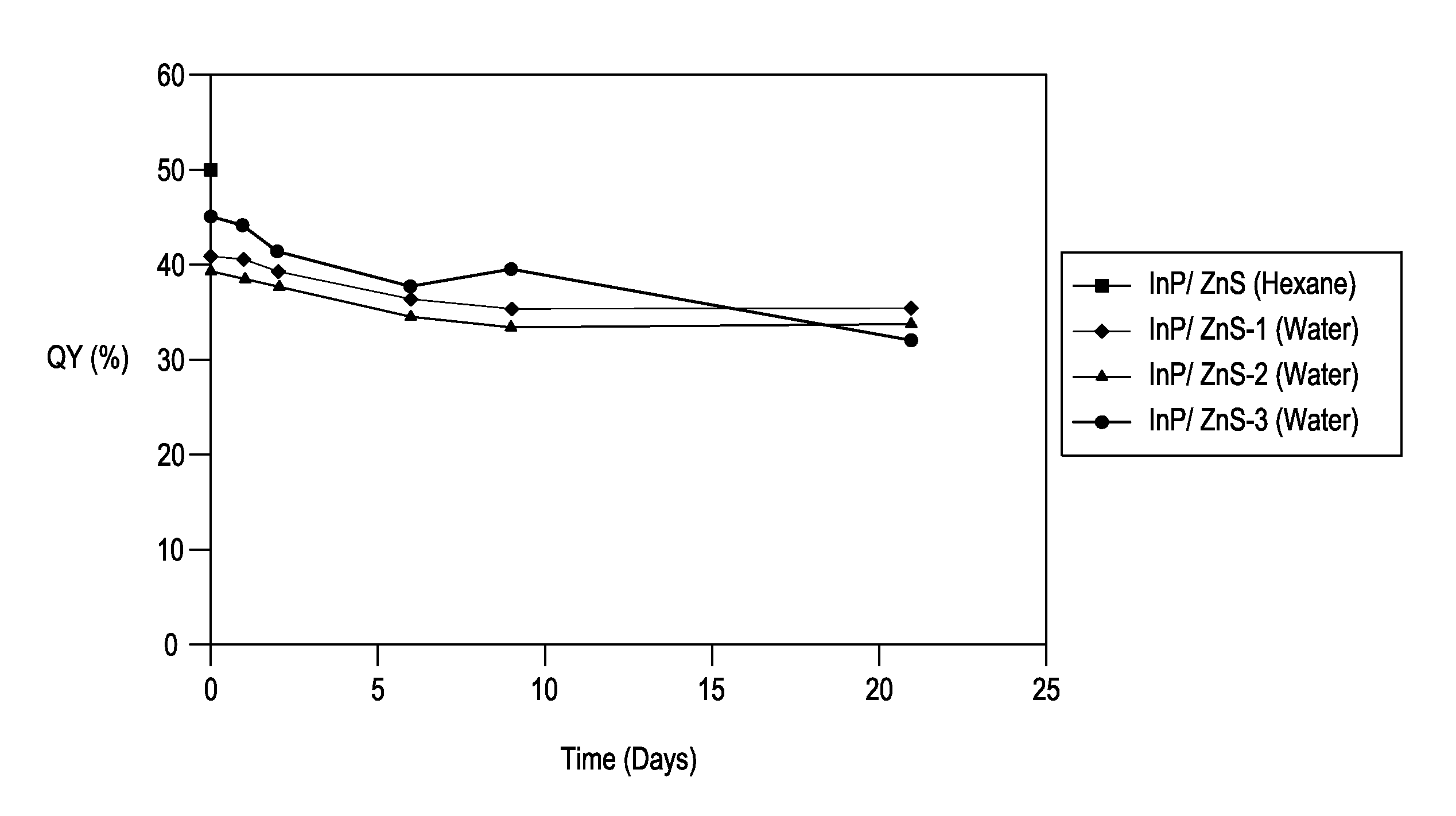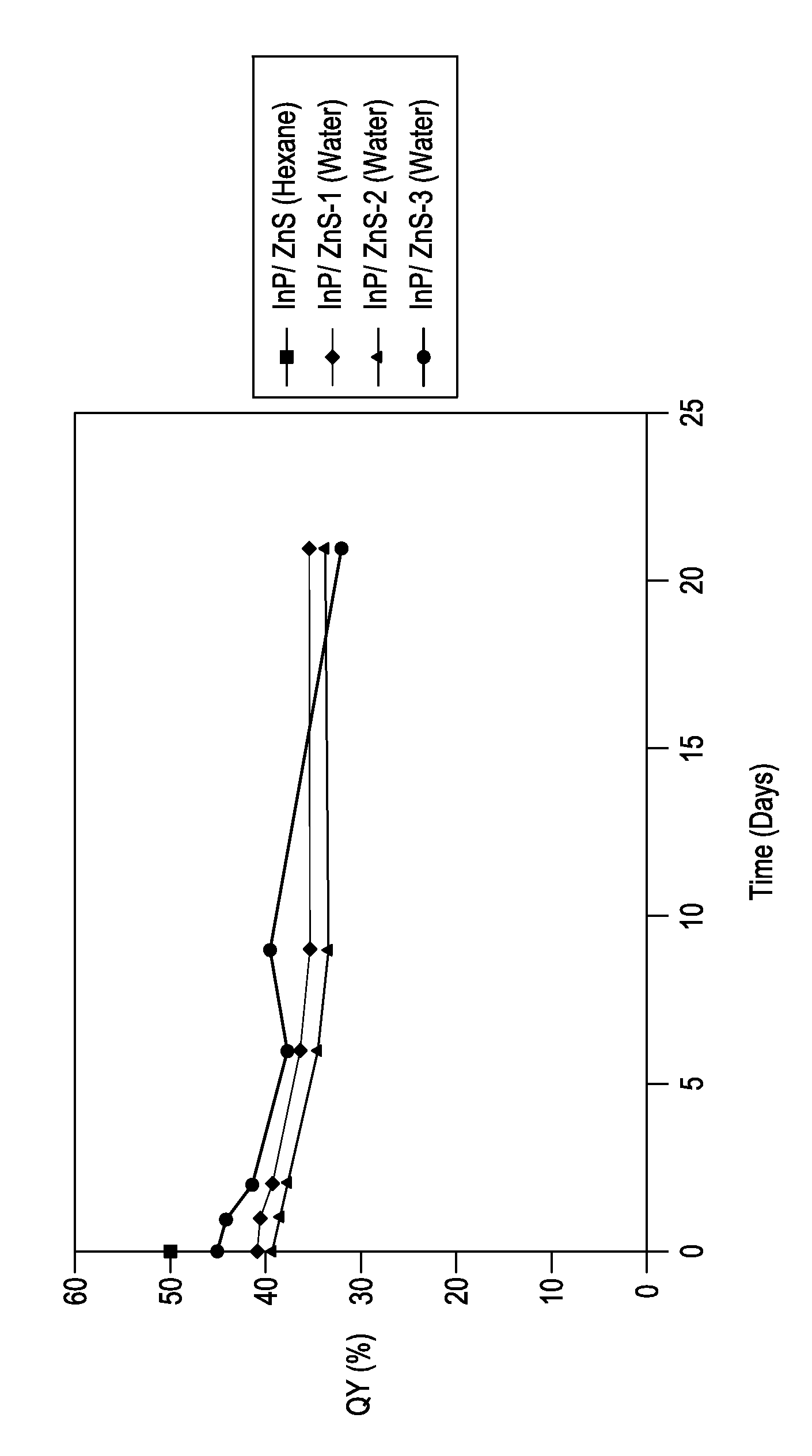Stable indium-containing semiconductor nanocrystals
a technology of indium-containing semiconductors and nanocrystals, which is applied in the direction of optical radiation measurement, powder delivery, spectral modifiers, etc., can solve the problems of incomplete destruction of inability to predict the bandgap properties of nanocrystal shells, and the inability to fully absorb the luminescence of nanocrystal cores, etc., to achieve low cost, prevent the incorporation of other elements, and reduce the effect of quantum yield
- Summary
- Abstract
- Description
- Claims
- Application Information
AI Technical Summary
Benefits of technology
Problems solved by technology
Method used
Image
Examples
example 1
Preparation of InP Core Nanocrystals
[0091]This describes an exemplary method for making InP nanocrystals. An InP core was prepared as follows. In a reaction flask under inert atmosphere, 0.88 g of indium acetate (In(OAc)3), 0.254 g oleic acid, and 14.8 g of 1-octadecene (ODE) that was purified to remove oxygen and water were combined. The contents of the flask were heated to 260° C. while a flow of nitrogen was directed through the flask to remove acetic acid as it formed. After 5 minutes at this temperature, the flow of nitrogen was stopped. A 0.02 M solution of tris(trimethylsilyl)phosphine (TMS3P) in ODE was prepared by adding 0.45 g of TMS3P to 7.101 g ODE. The contents of the flask were heated to 300° C. At 300° C., the TMS3P solution was quickly injected into the mixture. Nanocrystal formation was monitored by standard methods (achieving a desired fluorescence emission wavelength) until InP cores of the desired particle size was obtained, and the reaction was then cooled to ro...
example 2
Addition of ZnS Shell to InP Core
[0093]The InP cores were treated as follows to grow a ZnS shell on the core. To a reaction flask under inert atmosphere, 4.3 mL ODE, 238.5 mg of oleic acid, and 77.5 mg zinc acetate (Zn(OAc)2) were added. The mixture was heated to 260° C. and was then cooled to 80° C. While at 80° C., 4.9 mL of the washed InP cores prepared above, dispersed in n-hexanes, at an OD of 6.56, were added. The flask was placed under vacuum to remove hexane. The contents of the flask were then heated to 265° C. A 0.33 M solution of sulfur in oleylamine was prepared by adding 14.0 mg of sulfur to 1.04 g oleylamine. At 265° C. the sulfur solution was slowly added dropwise over a period of 75 minutes. After 75 minutes, 5.5 mL of trioctylphosphine (TOP) at room temperature was added to the reaction flask. The product is a population of quantum dots that are soluble in hydrophobic solvents (e.g., hexane, toluene, and the like) and stable for months. The product has an initially ...
example 3
Synthesis of Large InP Cores
[0094]To a 100 mL round bottom flask were added 2 mL of trioctylphosphine (TOP) and 100 nmol of purified InP cores in hexane from Example 1. The mixture was heated to 60° C. and a vacuum applied to remove hexane. In a second flask 0.141 g or anhydrous indium acetate, 0.410 g oleic acid, 12 mL of TOP, and 12 mL of 1-octadecene were added. The flask was heated under nitrogen to 250° C. and held there for a 5 minutes. The flask was allowed to cool to room temperature. The contents of the flask were loaded in to a syringe and mounted on a syringe pump. In an inert atmosphere glove box, 0.123 g of tris(trimethylsilyl)phosphine, 12 mL of TOP and 12 mL of ODE were mixed and loaded into a syringe. The syringe was removed from the glove box and loaded onto a second syringe pump. The core mixture was heated to 300° C. Once at 300° C., solutions from both syringe pumps were injected into the reaction flask at a rate of 33.6 μL per minute. After 8 hours the syringes ...
PUM
| Property | Measurement | Unit |
|---|---|---|
| temperature | aaaaa | aaaaa |
| thickness | aaaaa | aaaaa |
| size | aaaaa | aaaaa |
Abstract
Description
Claims
Application Information
 Login to View More
Login to View More - R&D
- Intellectual Property
- Life Sciences
- Materials
- Tech Scout
- Unparalleled Data Quality
- Higher Quality Content
- 60% Fewer Hallucinations
Browse by: Latest US Patents, China's latest patents, Technical Efficacy Thesaurus, Application Domain, Technology Topic, Popular Technical Reports.
© 2025 PatSnap. All rights reserved.Legal|Privacy policy|Modern Slavery Act Transparency Statement|Sitemap|About US| Contact US: help@patsnap.com


